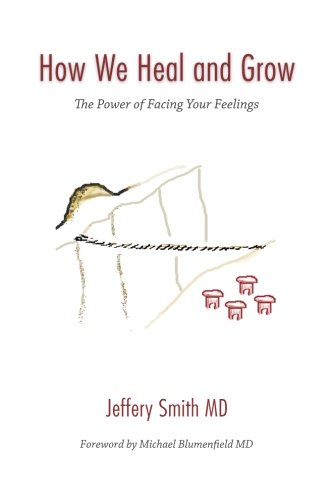Written by Jeffery Smith MD
Reviewed by Nancy Eichhorn, PhD
One word. That’s all it can take. One word. It doesn’t have to be a big word—nothing heady or obtuse. But a loaded word; one condemned by past connotations and associations. It’s basically just a word, but it’s tainted. And the person using the word? Well he becomes suspect, especially in our field when the word in question is catharsis.
The word, spoken aloud or read in a text, brings visual images of people screaming or crying, raging or lying in a fetal position unable to move from sheer exhaustion after venting stored emotions, often in the form of verbal tirades as well as physical actions.
Yet, this one word can mean something else. It can be used in a simpler, newer format if readers can let go of their hold on the past and embrace the word from a new perspective.
That’s what I had to do when reading Dr. Jeffrey Smith’s self-help book (2014) entitled, How We Heal and Grow: The Power of Facing Your Feelings.
When I first read the word, well, I balked. I debated, questioned myself, “Do I review a book that’s all about that?”
Then, I let go of the word and flowed with the sentence, then another and another and soon I was immersed in the text. It is informative, illustrative, illuminating. I felt a resonance with the material and allowed my background knowledge to be expanded, explored. I appreciated the structural layout of the book with stories and explanations, definitions and small snippets of data to explain principle points and key concepts—the details were just enough to instruct without overwhelming. I was guided through known territory and shown what I had been missing, gently, compassionately and completely. Voids were filled. Questions were answered. A sense of ‘I can use this’ pervasive at the end of each chapter, for myself and with clients. It is a book worthy of recommendation despite the fact he barely mentions the body and only gives Bessel van der Kolk and his work with body psychotherapy scant mention (more was definitely needed on the body in psychotherapy in my opinion but truth is this wasn’t meant to be a book about body-oriented psychotherapy).
Dr. Smith, a licensed psychiatrist in Scarsdale, New York, author and avid blogger (Healing and Growing), defines catharsis as “healing that takes place when feelings are shared with an emphatically attuned and safe other” (pg. 96). He explains that people use catharsis every day to cope with their feelings—“when we are upset, we naturally share our feelings with an
emphatic other” (pg. 105). And he delineates what it is not: true catharsis is not “scream therapy”, it is not the uncontrolled expressions of strong feelings. According to Dr. Smith, true catharsis “occurs when we experience and share authentic feelings, whether current or held somewhere in the mind, unprocessed since it was first experienced. When the
raw, unprocessed feeling comes into consciousness along with the original circumstances, in a context of connection, then permanent healing does happen” (pg.115).
Attunement, being with, creating safe environments have been part of Dr. Smith’s approach for 30 plus years as well as part of his teaching style—he teaches psychotherapy for psychiatrists in training at New York Medical College. Over the past 15 years he has focused on tools to help therapists understand and guide their therapeutic approach/process across behavioral and psychodynamic lines. According to his website, “His main interests are in psychotherapy and in deepening our understanding of the central problem of what exactly helps people change. Experience with survivors of severe trauma and with people suffering from addiction and other compulsive behaviors has given him a broad perspective on therapy
including both behavioral and psychological aspects. He sees talking therapy as a sharp instrument giving us access to the precise places in the brain where change needs to take place” (http://howtherapyworks.com/).
He calls himself an “old fashioned psychiatrist” saying he talks more than prescribes. I have a sense he listens more than he speaks. He creates metaphors for change beginning with the opening story about a man needing to cross a bridge, which are filtered throughout the text. He creates new terminology to explain motivations, behaviors, and places that harbor
resistance to change. For instance, in Chapter 2 on Avoiding Feelings, he introduces the Black Box Motivator. Dr. Smith invented this term to “capture that part of the mind that produces impulses and thoughts exquisitely designed to be effective in steering conscious free will in directions that the mind presumably (because its operation is not available to
consciousness) considers necessary for survival” (pg. 87). This is not our friend, mind you. It motivates us to do things that are not in our best interest—it’s the underlying shyster that wrangles us into bad situations under false pretenses. Yet, Dr. Smith explains, “When our Black Box Motivator produces automatic thoughts and impulses that steer us towards
unhealthy behavior, we can seek support and fight back” (pg.90). Chapter 4 introduces our intellectual Castle that becomes a Prison with a discussion on automatic thoughts, ideas that block acceptance and forgiveness, and the need for conscious awareness including a discussion on explicit and implicit memory. Neuroscience (terms and definitions) aid his conversation along with tools for inner exploration.
There’s clearly a teacher writing this book and directing the layout. Different therapeutic approaches are mentioned (i.e., EMDR, exposure therapy, experiential-dynamic psychotherapy, trauma therapy, mindfulness), professionals and their contributions (i.e., Diana Fosha, Francine Shapiro, Daniel Stern, Erik Erickson, Margaret Schoenberger Mahler, Peter Fonagy, Daniel Siegel), and key concepts such as object constancy and “what isn’t conscious doesn’t change” (pg. 111). Dr. Smith also weaves in case examples, short vignettes bring key concepts to life, open the material experientially to see his thoughts and process in action. “Next Steps” conclude each chapter directing readers to use the tools offered and offering
ways to incorporate the material (guiding questions help readers focus). And there are references at the end of each chapter for books and articles mentioned (APA format).
Your Conscience Can Be Wrong. Chapter 5 introduces characteristics of the Superego, putting it into perspective and how to change its unhealthy contents (with reference to Aaron Beck, the father of cognitive therapy and Albert Ellis, who originated rational emotive behavior therapy). Chapter 6 begins the practice of voluntarily changing behavior by looking at five developmental periods that result in five groups of behavioral patterns. He also delves into obsessions and
compulsions and dissociation and depression (which was addressed in Chapter 2 as well). An interesting discussion in Chapter 6 revolves around hidden agendas, which he describes as “behavior patterns originally aimed at influencing the adults in a child’s life” (pg. 218). Agendas can focus on a variety of needs and “people with hidden agendas are not only unaware of the messages they send, but they also place high value (meaning the conscience is involved) on being ‘good people’” (pg.221).
Addictions are dealt with throughout the book as the result of the motivational system being hijacked, as an epigenetic precursor—genes are involved that determine who develops one and who doesn’t (an inborn strategy), and as a means to cover up feelings—they become universal coping mechanisms for every stress. In Chapter 6’s Next Steps, there’s a methodical
approach to deal with addictions as they remain one of the harder behaviors to change, including developing a support system, making a plan, and finding sober/abstinent role models and friends. Dr. Smith is quite clear that while it is written as a self-help book, it is also written as a companion for individual therapy and/or group therapy. The emphasis on
attunement with a safe resonant other matters.
Dreams and Quests (Chapter 7) and Arrested Development (Chapter 8) bring readers to the final chapter: The Future Starts Today. Dr. Smith introduces the Scarsdale Psychotherapy Self-Evaluation (SPSE), a tool to help readers evaluate therapeutic effectiveness. It is designed to help users consider what is important in therapy and is based on the “universal and principles laid out in the book.” (pg. 301). The test is included in Chapter 9 and available online (www.blog.psytx.com). There is also a glossary and biography section to clarify terms and professionals noted in the text.
I took my time reading this book, experimented with some of the “tools” offered, reflected on key concepts and their application to my own life and my clients. As noted earlier, I felt a resonance with the material. While the concepts offered were not new to me, I did feel a clearer understanding in the sense of how they all interact, a tapestry of attunement, attachment, developmental theory, mindfulness, psychoanalysis, psychology, psychiatry, self and other. A
relationship formed between myself and the text, between the external conscious Self and the internal subconscious self as we roamed into the unconscious through metaphor and behavior (looking at patterns as signals for something deeper lying underneath). I appreciated the experience and the resultant expansion I’m living with now.
Smith, Jeffrey. (2014). How to Heal and Grow: The Power of Facing Your Feelings. White Plains, NY: Libentia Press.




